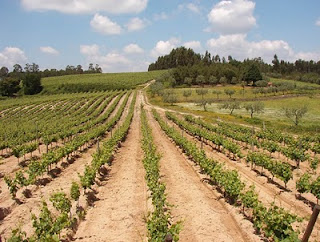Portugal and Spain share the same peninsula in the southwestern edge of the European continent, yet have remained distinctly independent neighbors throughout history.
From the westernmost corner of Moorish Spain, the Jerez, where the white, chalky albariza soils grow the best Palomino grapes in blinding sunshine, producing my beloved Sherry, to the rainy estuary lands that are the Celtic influenced Minho province of Vinho Verde and the early harvested(green)wine that shares its name, this edge of the old world is richly steeped in cultural extremes.
Shared history has seen the armies of numerous invaders marched across this landscape. Celtic "Lusitanians", with their similar culture, had already integrated into the Northern territories, long before the 8th century would see a conquest coming from Africa across the South. Spain had seen the Romans and the Visigoths before the Islamic conquest, and not until the domestic Castile & Aragon unification of 1492, allowed this nation to became whole. Portugal saw the Romans, Visigoths and Moors too, yet, perhaps due to its rugged landscape and smaller size, was able to drive out the foreign invaders and become an independent kingdom much earlier in 1139. The wine production of these Iberian neighbors was being forged time and again by each wave of incursion.
Alliances with other kingdoms established important trade routes, and the Age of Discovery that followed brought a world of new products and opened new markets for the goods(wines)Portugal. Imperial Spain stretched its reach across the ocean trade routes too, on the way to becoming a global empire. Along the way, developing trade with England, France and Flanders influenced the design and evolution of the wine industries of these Iberian neighbors. Would there be a great Port, like Dow's and Taylor-Fladgate without the English and the Methuen Treaty? Is it possible that without the early Dutch developed methods of fortification(brandy) and sulfuring, Spanish wines evolving time line would have been significantly delayed?
Standardization, forced by the European Union, has brought these neighbors into the contemporary world, upgrading their viticulture and wine classifications. Today, Spain has the largest grape acreage in the world, dominated by the white grape Aire'n. One of its principal grapes, Tempranillo, is known by the synonyms Cencibel, Tinta del Pais, and Catalonia's Ull de Llebre, underscoring the fractured, independent history of a single countries noble grape. In Portugal, this same grape is known by the name Tinta Roriz, and is one of the national grape pillars(among 4 others) of fortified Port wines.
But a new history is being written. Spanish Denominacion of Origen's of Toro, Rueda and Ribera del Duero, north of Madrid, are following similar new world trade routes to establish exciting, high quality wines from these improving provinces. Priorat, DOCa, sitting between Barcelona and Valencia, is emerging today as Spain's most important up and coming wine region based on wines from the red rustic Carinena (carignan). Even old traditions of Portugal are modernizing in regions beyond Vinho Verde, like the improving table wines of the Dao and the Douro DOC's. The clay soils of Bairrada DOC, known for the rich reds of Baga and the bright white Maria Gomes varieties, have long been consumed domestically and today can be increasingly found in our local wine shops.
Quality wines from these two independent Iberian neighbors today offer a chance to taste their great histories in each glass. They are unique, value driven wines that can enhance the histories each of us make, and allow us to celebrate greatness found in independence.
Cheers!, A Sia Saide, and Salud!



No comments:
Post a Comment